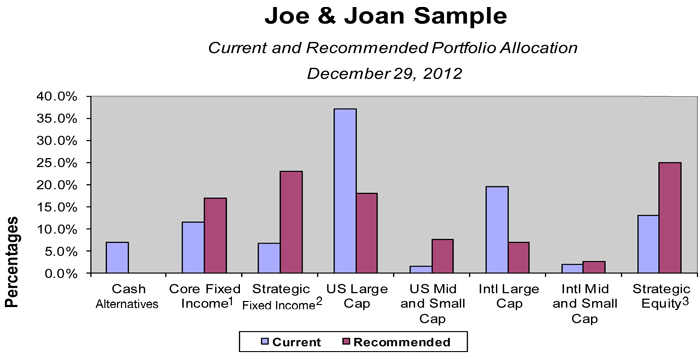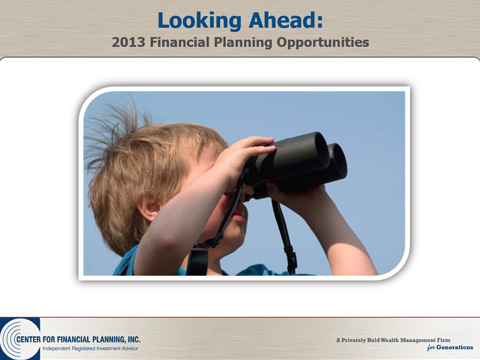“Happy New Year!” At least that’s what stock markets seem to be thinking. While 2012 posted solid returns across asset classes, 2013 has had a more exaggerated “off to the races” feeling for stocks. Money which was piled up on the sideline, whether from fear of the fiscal cliff or general concerns or fatigue, seems to be rushing back in to riskier investments like stocks.
Who hasn’t been happy in the new year? Government bond holders have a slight taste of potential negative returns as interest rates rose. The Barclay’s Capital Aggregate Bond Index returns fell by 0.70% through the end of January. Interest rates have risen in several small periods over the past year with some corresponding bond losses, but a clean slate of fresh “Year to Date” performance numbers may highlight these negatives more easily than hiccups buried within the year.
US GDP growth from the 4th quarter was markedly lower than expected falling by 0.1% as reported by the Commerce Department. What was ailing the US economy? Much of the blame goes to reduced spending, especially in the defense sector as there was anticipation of spending cuts related to the fiscal cliff. This is likely to be revised upward, though, because the trade deficit narrowed unexpectedly during the end of the year.
Washington’s grip on business page headlines is not done, but an agreement to avoid the so-called fiscal cliff as well as delay the debt ceiling limits seems to have been a welcome break from posturing and threats for a few weeks. We still have spending cuts to deal with in the next couple months so the respite may be short-lived. We are not fans of can kicking, but we also do not want government dysfunction to hijack the investment realm. We’ll keep you posted as developments unfold.
While growth has been muted, employment numbers continue to slowly look better as more people return to look for jobs and less new unemployment claims are registered. These numbers are an important factor in our economic picture today and while the US unemployment recovery is certainly sluggish, the direction of the numbers (more jobs, less unemployed) remains critical. In tandem with unemployment is housing which has been a major drag to the economy since 2008. Encouraging positive numbers have been reported from 2012 into 2013 for both housing prices and activity. This is a welcomed trend!
US economic reports aren’t the only positives. The notion of recovery is starting to be contemplated in Europe and while the Euro economies certainly aren’t out of the woods, the Euro itself seems more viable. In China, new leadership has also allayed fears of a hard landing in Asia. In the US, corporations continue to post strong earnings and a new reality in domestic energy production is starting to change some dynamics for US competitiveness.
January’s buying stampede cannot sustain itself for 12 months and we’re sure 2013 will have its investing ups and downs as does any other year. That said, those who continually forecast doom and gloom for US markets would be hard-pressed to explain the rising tide we’ve witnessed since the beginning of 2012.
Things are never as good or as bad as they may appear. Better returns may tip the investing scales from fear to greed. Don’t get too excited chasing returns of yesterday. We still recommend a prudent, diversified and consistent approach to investing as you strive to reach the finish line for each of your personal financial planning goals.
On behalf of everyone here at The Center,
Melissa Joy, CFP®
Partner, Director of Investments
Required Disclaimer: The information contained in this report does not purport to be a complete description of the securities, markets, or developments referred to in this material. The information has been obtained from sources considered to be reliable, but we do not guarantee that the foregoing material is accurate or complete. Any information is not a complete summary or statement of all available data necessary for making an investment decision and does not constitute a recommendation. Any opinions are those of Melissa Joy, CFP® and not necessarily those of RJFS or Raymond James. Investing involves risk and diversification does not ensure a profit or protect against a loss. There is an inverse relationship between interest rate movements and bond prices. Generally, when interest rates rise, bond prices fall and when interest rates fall, bond prices generally rise. The Barclays Capital Aggregate Bond Index is a broad base index maintained by Barclays Capital and is often used to represent investment grade bonds being traded in United States. Keep in mind that individuals cannot invest directly in any index, and index performance does not include transaction costs or other fees, which will affect actual investment performance. Individual investor's results will vary. Past performance does not guarantee future results.

 Lee and Susan Riddell, longtime clients of Marilyn Gunther, CFP® have been Center Clients for nearly 25 years. Susan is a gifted quilter and crafts person. Lee retired from a career at Ford Motor Company and was recently featured in an article written by Robert Norris for Cincinnati.com, a Gannett Company.
Lee and Susan Riddell, longtime clients of Marilyn Gunther, CFP® have been Center Clients for nearly 25 years. Susan is a gifted quilter and crafts person. Lee retired from a career at Ford Motor Company and was recently featured in an article written by Robert Norris for Cincinnati.com, a Gannett Company. 













